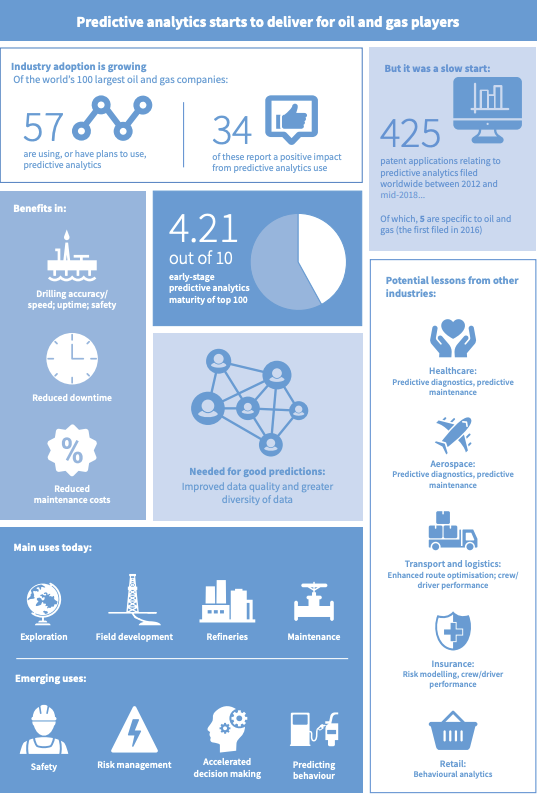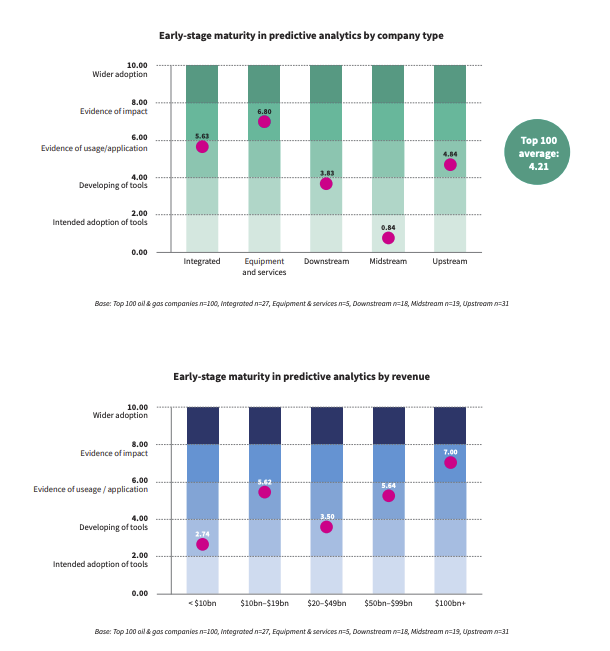The OGM Interactive Edition - Summer 2023 - Read Now!
View Past IssuesA new industry report produced by Lloyd’s Register (LR) – reveals the pace, development and adoption of predictive analytics in the oil and gas sector. The report brings in to focus how different companies are using predictive analytics and to what extent companies are transforming their own technology and data capabilities to predict a better performing and sustainable future between operators, service providers and technology makers.
Industry executives and other experts interviewed for this report have identified several fields of predictive and other advanced analytics application – and the industries where they are being used – that hold potential for oil and gas. The report indicates adoption is a reality now.

Proving return on investment (ROI) to management may take time, but is feasible Companies using predictive analytics in unconventional wells have often been able to tie its use to demonstrable gains in improved drilling accuracy, efficiency or cost savings. Doing the same for predictive use in maintenance and safety is less straightforward when avoidance of incidents or downtime are the main benefits. Efficiencies from these can be quantified, however, and 2–3 more years of running and validating algorithms and accumulating databased evidence should help many firms to demonstrate returns they have difficulty proving today. Predictive analytics is delivering benefits today Based on publicly available evidence, 57 of the world’s 100 largest oil and gas firms are using, or have plans to use, predictive analytics. Over half of these companies (34) report that their use of such tools has had a positive impact of varying degrees. Within the top 100, evidence of predictive adoption and use is most extensive upstream, in oil-field equipment and services, exploration and production. It is the largest firms in terms of revenue and market capitalisation (mainly integrated oil and gas companies) that appear to have advanced furthest with the technology.
Fields of application are widening beyond reservoir performance Several large oil and gas companies have put predictive analytics to good use upstream, earning returns from improved performance of unconventional wells. Maintenance, safety and production control are newer areas of adoption. Companies are exploring future uses of predictive tools in combination with emerging technology capabilities such as machine vision4 and behavioural analytics. Use cases in other industries may hold potential in oil and gas Industry firms are scanning the health, aerospace, financial services and other industries for examples of predictive analytics use in equipment diagnostics, prognostics and maintenance, pricing and risk management. Other relevant use cases include machine vision in the automotive, sport and healthcare industries; behavioural models in the retail and financial services industries; and enhanced route optimisation used by transport and logistics firms. Data quality issues hamper predictive analytics use, but these can be surmounted Data quality and availability are viewed as the chief impediments to the use of predictive analytics in the industry. Oil and gas companies collect masses of data, but often can only access a small portion of it.
Standardising disparate sources of data can also be difficult. Experts say, however, that data quality need not be perfect, and that workarounds are possible. Using advanced data science, for example, companies can filter data to overcome quality problems.
New data sources are gradually becoming available Accessing the external data and expertise needed to make predictive analytics work requires oil and gas firms to widen the scope of their interaction. For example, the world’s technology giants support open platforms for developing algorithms, as well as data lakes and cloud platforms that provide great analytics power. Some executives interviewed for this study say their firms are benefiting from access to data and expertise on such platforms.

– $325,000 per rig using machine learning to predict drill-bit locations
– saving costs of $7 million on gas pipelines in the eastern US through predicting failures
– machine learning to improve safety improvement capabilities
– in unconventional wells to change management attitude
– behavioural modelling to reduce the frequency of safety incidents
– exploring fully automated drilling platforms
– automated analysis of subsurface data
– designing the ‘rig of the future’.
The research sought the insights and opinions of leaders across the sector, such as: Eric Abecassis, CIO, Schlumberger, Stephen Ashley Manager, Digital Transformation Solution Centre, Oil & Gas Technology Centre, Willem van Asperen Director, applied artificial intelligence, PA Consulting Group, Richard Barclay Manager, Advanced analytics, ConocoPhillips, Margery Connor Leader, Data science capability and Technology, Chevron, Daniel Jeavons General manager – data science, Shell, Michael Jones Senior director of strategy and M&A, Halliburton Digital Solutions, Adam Judelson Founder and CEO, Cognotient, Neil Kavanagh Chief science & technology manager, Woodside Petroleum, Narayan Laksham Founder and CEO, 4casting Systems, Joel Meltzner CEO and president, i4 Insight, and Morten Møller Pedersen Deputy asset manager, Maersk Drilling.
“This report makes clear that the oil and gas industry still has much to do to lay a solid foundation for using predictive technologies effectively,” says Nial McCollam, Chief Technology Officer of LR. “Companies will do this by solving data quality and standardisation issues, and establishing the external relationships that will give them access to the large volumes of data they need.”
Making the most of data requires more than advanced analytics tools and skilled data scientists. The report reinforces the fundamental need to successfully collect and transmit data to help with better decision making. McCollam says: “Recent advances in data analytics technologies – predictive analytics in particular – and networked sensors offer companies the opportunity to greatly widen and systematize the scope of their forecasting to include operational processes up and down the value chain.”
Contributors to the report highlight the critical areas for predictive analytics including demand forecasting, oil and gas trading, spare parts inventory management, transport route optimisation, process control and facility management.
“The Technology Radar report finds that many of the industry’s largest companies are actively developing predictive capabilities using internal and external resources,” says McCollam. “At least one-third of the top 100 industry players by size are generating a beneficial impact from using this technology. Sure, there is a long way to go, but adoption and new ways of thinking and working is becoming a reality.”
By using large volumes of historic seismic and production data, existing and new sensors, and powerful algorithms, companies have unlocked insights not previously available to them, which has boosted efficiency and productivity, reduced downtime, and earned them demonstrable returns along the way. Unconventional wells, mainly in North America, have been the biggest early beneficiaries of predictive analytics to date.
Predictive analytics are now coming to bear in asset maintenance – human and equipment. McCollam says: “Foreseeing and preventing events that lead to injury, loss of life or environmental damage is a key part of predictive analytics – and even more so in driving efficiencies and enhancing performance.”
“The ability to predict erosion and lifespans of equipment such as drills, pumps and other rig equipment promises considerable savings. And we are also seeing companies begin to experiment with predictive analytics in behavioural modelling to help identify symptoms of unsafe human behaviour, and predicting when certain behaviour traits are likely to create high-risk situations.”
“Along with our clients and partners, we believe that the use of predictive analytics can lead to both improved performance and enhanced safety and better risk management. Encouragingly, the findings of this special edition of the LR Technology Radar show that this potential is beginning to convert into reality.
The report highlights how the experience of predictive analytics used in consumer markets can provide better insights into how more accurate predictions are generated when multiple sets of data from different sources are layered up.
“Distilling these lessons can only help oil and gas companies to adapt using cases perfected elsewhere, and inspire us to develop innovative ones of our own. However, the report also highlights that governments, regulators and industry leaders have a critical part to play by fostering environments in which oil and gas companies can share data with confidence, and without fear that the data that is shared will be turned against them from an environmental performance or safety perspective.”
This is the fourth year LR has conducted its award-winning Technology Radar research. Whilst earlier editions have focused on macro energy insights of the oil and gas sector and low carbon power generation, this time around, the research concentrates on predictive analytics in oil and gas, with a focus on operation performance, safety, technology, analytics design, machine learning, human behaviour, policy, safety, public appetite and acceptance.
The 2018 Technology Radar Oil & Gas report is published as of November 12, 2018.
Go to www.lr.org/predictiveanalytics to download the 2018 Technology Radar Oil & Gas report and findings.
Started out in 1760 as a marine classification society. Today, one of the world’s leading providers of professional services for engineering and technology – improving safety and increasing the performance of critical infrastructures for clients in over 75 countries worldwide. The profits generated fund the Lloyd’s Register Foundation, a charity which supports science and engineering-related research, education and public engagement around everything they do. All of this helps us stand by the purpose that drives their purpose of Working together for a safer world.
In a world of increasing complexity – overloaded with data and opinion – we know that our clients need more than technology to succeed. They need an experienced hand. A partner to listen, cut through the noise and focus on what really matters to them and their customers. Our engineers and technical experts are dedicated to assurance. That means a commitment to embracing new technology, and a deep-rooted desire to drive better performance. So we consider our customers’ needs with diligence and empathy, then use our expertise and over 250 years’ experience to deliver the smart solution for everyone.
After all, there are some things technology can’t replace.
Global research, sector insights and in-country reports and industry surveys form part of the Technology Radar series managed by the energy business of LR. The reports combine LR’s expert knowledge with third-party insights, to provide data-driven findings on the role of innovation, technology, safety and sustainability in the current and future energy industry.
Our role at LR is to ensure that we provide that independent viewpoint help government, energy producers, manufacturers, regulators and policymakers to the energy industry extract energy safely, and to deliver energy sustainably, with minimal risk to people and to the environment, and in socially responsible ways. We recognise that true value can be created by nurturing stakeholder relationships, based on trust and understanding.
LR is addressing the industry’s most significant technology and sustainability challenges by interacting and working with energy stakeholders on an ongoing basis. Through interviews with senior industry practitioners and surveys of energy professionals, the Technology Radar series provides a compelling insight into the latest industry thinking, trends and insights.
Source: Lloyd’s Register for graphics and content
Did you enjoy this article?